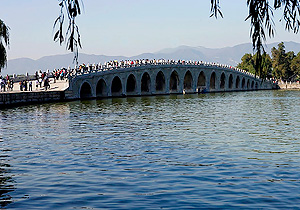Summer Palace

Summer Palace is situated about ten kilometers from Beijing City. Numerous ornate temples, pavilions, and winding corridors and the vast lake rank the park as one of the top attractions in Beijing sightseeing list.
Summer Palace was a loyal garden and enlarged and refined by the Qing dynasty Emperor Qianlong from 1750 to 1764 to celebrate his mother's 60th birthday as well as to adjust the northeast water system. But this imperial palace had been seriously tramped by Anglo-French intruder troops in 1960 and eight allied armies in 1900. Empress Dowager Cixi--the last of the Qing dynasty rulers diverted the navy funds to the long restoration haul. With 2.9 square kilometers (290 hectares), this largest Chinese imperial garden mainly consists of three functional areas: the political affair area, the living area and the sightseeing area.
The political affair area, on the east side of the garden, has Hall of Benevolence and Longevity as the main architecture where the emperor handled the nation affair and welcomed the foreign diplomats. The masculine dragon statue pair standing aside the feminine phoenix pair as the subordinate companions in front of the hall well displays that Empress Dowager Cixi broke the traditional feudal custom that female should obey man's will and never interfere the politic and issued her reign ambition and indicated her actual political position. The god of longevity rock statue, silver mirror carved with many longevity mascots and characters, bronze beast kylin statue, the symbol of Longevity and the honest well echo the hall's benevolence and longevity themes.
Behind the Hall of Benevolence and Longevity is located the living area for the imperial families and mainly composed of three large-scale connected quadrangles: Hall of Joyful Longevity, Hall of Jade Billows and Chamber of Mortal Beings. The abundant decorations here has more life-touch and are more relaxing like rich precious plants and flora, and well-layout living rooms filled with dressing mirrors, jewel works, dragon-carved wardrobes, even the fashion clocks and German color ceiling lamps.
The sightseeing area on the north side is the garden highlight and mainly divided into Longevity Hill and Kunming Lake.
Longevity Hill, on the northern bank of the Kunming Lake, consists of the Front Hill and the Rear Hill. Front Hill is full of the gilded architecture cluster of Buddhism theme which the ruling class integrated in the building in the hope of strengthening their dominance: The axis-located Buddhist Fragrance Pavilion, Cloud Dispelling Hall and Buddhist Temple of the Sea of Wisdom as well as Long Corridor on the south shore. As Buddhist Fragrance Pavilion is the principal building in the whole garden, its leading central position is highlighted with balanced distribution of pagodas and pavilions. The Long Corridor with its winding and rolling over-700-meter stretches has well linked the separate hills, water and the architectures while displays China stories and histories and poetry for thousands of year in its over 8,000 intricate corridor beam paintings. A climb up to the top of the 60-metre Longevity Hill is advised to have a overlook view of those beauties.
The Rear Hill, with less architecture, is the densely planted and quiet and elegant, featuring Suzhou Market Street, the Garden of Harmonious Interests, etc. Suzhou Market Street is lined with the grey-brick-tile shops for the isolated imperial members to experience the folksy life fun. The Garden of Harmonious Interests that was based on its copy--Jichangyuan Garden in Wuxi of Suzhou City, has finished the restoration and opens its former closed door to the tourists in 2010. The place is dotted with all what a classic South China garden requires like pavilions, corridors, a little pond, stoned bridges, towers, etc and thus is known as the "garden in the gardens".
The 2.2- squares Kunming Lake taking up of the three-quarters of the park is a manmade project and the excavated soil was piled to built the Longevity Hill. The overlook shape of the lake just resembles a big peach, which has the longevity blessing wish in Chinese culture and is said to imply the good wish for the Qianlong Emperor's mother. The willow-lined banks, 17-arch bridge, architecture-adorned lake island are better to take in via the cross-lake ferries.